8 Filipino Dishes Tourists Overrate—And 9 Must-Try Favorites Locals Actually Love

Filipino cuisine offers an intriguing mix of flavors, deeply rooted in the country’s rich cultural heritage. While some dishes are lifted to fame and adored by tourists, others remain cherished secrets among locals. This list explores 8 Filipino dishes that often captivate tourists but may not always be the locals’ top picks, and also highlights 9 dishes that are truly loved and celebrated by Filipinos. Discover which culinary delights are truly reflective of the Filipino spirit, whether through their comforting flavors, historical significance, or unique preparation.
1. Balut
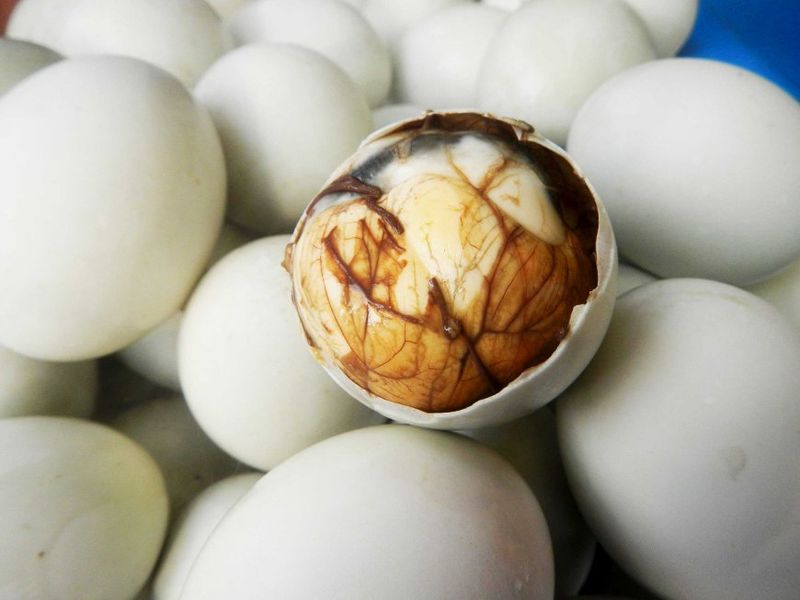
Balut is often seen as a daring snack for tourists. This fertilized duck egg is consumed by some locals, but it’s not an everyday choice for many. The uniqueness of balut lies in its texture and the experience of consuming an embryo, which intrigues adventurous eaters. While it holds a place in Filipino street food culture, it’s consumed more for its novelty rather than regular enjoyment. Tourists often highlight the shock value, making it a popular topic of conversation. Despite the attention, locals may not frequently indulge in it as part of their regular diet.
2. Halo-Halo (with too many mix-ins)

Halo-Halo, with its myriad of mix-ins, sparks curiosity among tourists. While visually appealing with vibrant ingredients like jellies, fruits, and sweet beans, locals often favor a simpler version. This dessert can become overly complex with too many toppings, diluting its traditional taste. The essence of halo-halo is in its balance, where each component complements the other. Locals enjoy a more understated version that allows the creaminess of the shaved ice and milk to stand out. Tourists, however, are drawn to the colorful spectacle, making it a must-try for many visitors.
3. Lechon Kawali (over Lechon)
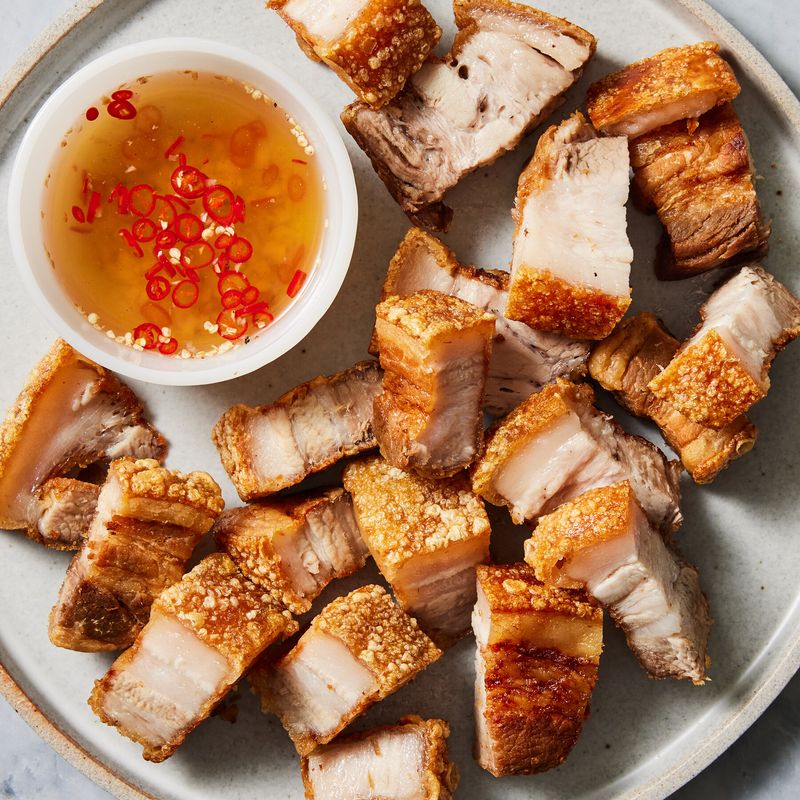
Lechon Kawali, a deep-fried pork belly, is sometimes mistaken for the more traditional lechon. This confusion often leads tourists to misjudge the dish’s significance. While lechon kawali offers a crispy, savory delight, it lacks the grandeur of a whole roasted pig. The preparation of lechon involves a slow-roasting process that results in tender meat and crispy skin, celebrated during festive occasions. Lechon kawali, though delicious, doesn’t capture the same cultural depth. Tourists might opt for this version for convenience, but locals cherish the communal experience of a traditional lechon feast.
4. Pancit Canton (Instant Noodle Version)
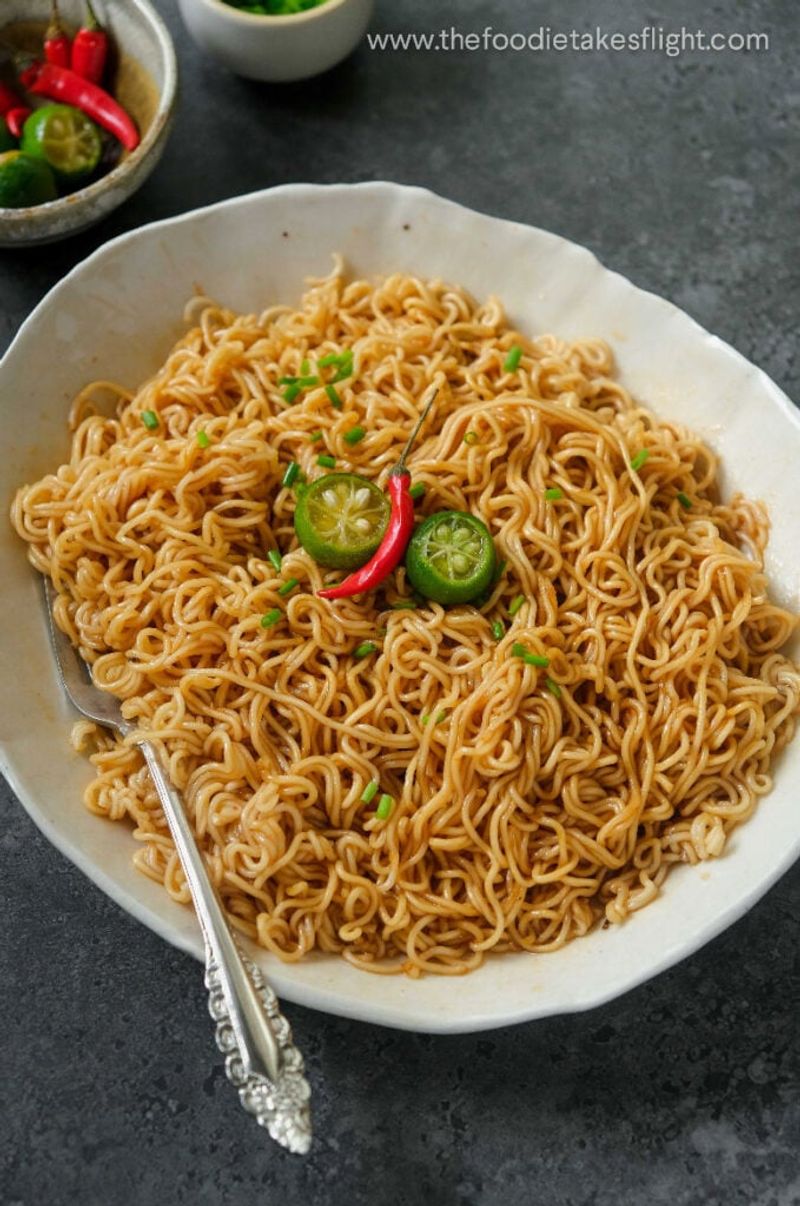
Pancit Canton often brings to mind instant noodles for tourists, overshadowing the authentic homemade version. While convenient, the instant variety lacks the rich flavors of freshly cooked pancit canton. This Filipino noodle dish, made with sautéed meats, vegetables, and soy-based sauce, is a staple at gatherings. Locals appreciate the nuanced taste that comes from cooking it from scratch, often adding personal touches. Instant pancit canton offers quick satisfaction, but true appreciation lies in the home-cooked version. Tourists might miss out on this culinary delight by settling for the packaged alternative.
5. Isaw (Grilled Chicken Intestines)

Isaw, grilled chicken intestines, appeals to adventurous eaters exploring street food. Its unique texture and smoky flavor attract tourists seeking culinary thrills. However, hygiene concerns and the chewy consistency make it less appealing for regular consumption by locals. Often enjoyed by specific crowds, isaw is a testament to the adventurous side of Filipino street food culture. It symbolizes a willingness to explore new tastes and textures, albeit with caution. While tourists may eagerly try it, locals usually reserve it for occasional indulgence rather than a daily treat.
6. Turon (Banana Lumpia)

Turon, or banana lumpia, is a sweet snack that often captivates tourists. Its crispy exterior and soft banana filling offer a delightful contrast. While delicious, it sometimes gets overhyped as a cultural icon. In reality, turon is one of many merienda options that locals enjoy casually. Its simple preparation involves wrapping bananas and sometimes jackfruit in spring roll wrappers before frying. Although it holds a special place in Filipino snacks, it doesn’t encompass the entire range of the country’s diverse culinary repertoire. Tourists, drawn to its simplicity, often see it as a must-try.
7. Ube Everything (Trendy Desserts)

Ube, a purple yam, has gained a trendy status in desserts, leading to an explosion of ube-flavored treats. Tourists often encounter ube doughnuts, ice creams, and even milkshakes. While these modern takes are visually captivating, they may not always capture the authentic flavor of traditional ube halaya. Locals cherish the rich, creamy texture of homemade ube halaya, which is often enjoyed on its own or in classic desserts. The trendy versions attract tourists eager to try something new, but the essence of ube lies in its traditional preparation.
8. Taho (from tourist traps)

Taho, a beloved morning snack of silken tofu, syrup, and sago pearls, is best enjoyed fresh from early-morning street vendors. Tourists often encounter premade or overly sweet versions in tourist spots, which can detract from its authentic taste. The beauty of taho lies in its simplicity and the personal touch of vendors who serve it warm and fresh. Locals savor this comforting treat as part of their morning routine. While tourists might experience a diluted version, the true essence of taho is found in the quiet streets where locals begin their day.
9. Sinigang

Sinigang, a tangy soup made with tamarind, pork, shrimp, or fish, and various vegetables, is a comforting staple in Filipino households. Its sour, savory broth is both refreshing and hearty, making it a favorite among locals. Each household has its own variation, adding a personal touch to this beloved dish. The combination of ingredients creates a harmonious balance of flavors, perfect for pairing with steamed rice. Sinigang’s popularity among Filipinos is unwavering, as it embodies the essence of home-cooked comfort food. Visitors seeking an authentic taste of Filipino cuisine should not miss this dish.
10. Kare-Kare
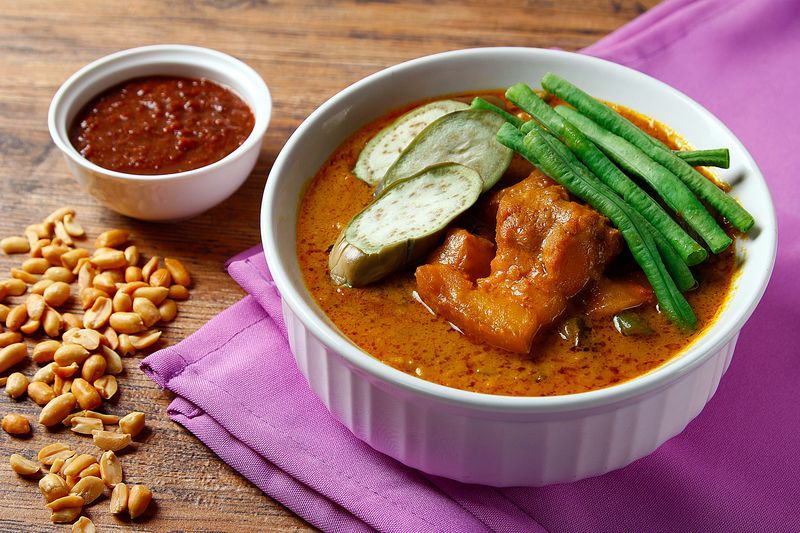
Kare-Kare is a rich, peanut-based stew that holds a special place in Filipino culinary tradition. Often made with oxtail, tripe, and vegetables, it’s served with bagoong, a fermented shrimp paste, which enhances its flavor profile. This dish is a celebration of textures and tastes, where creamy and savory elements meld beautifully. Kare-Kare is a highlight at family gatherings, symbolizing the warmth and togetherness of shared meals. The unique combination of ingredients creates a distinct experience that locals treasure, making it a must-try for anyone seeking to understand Filipino culture through its cuisine.
11. Adobong Pusit
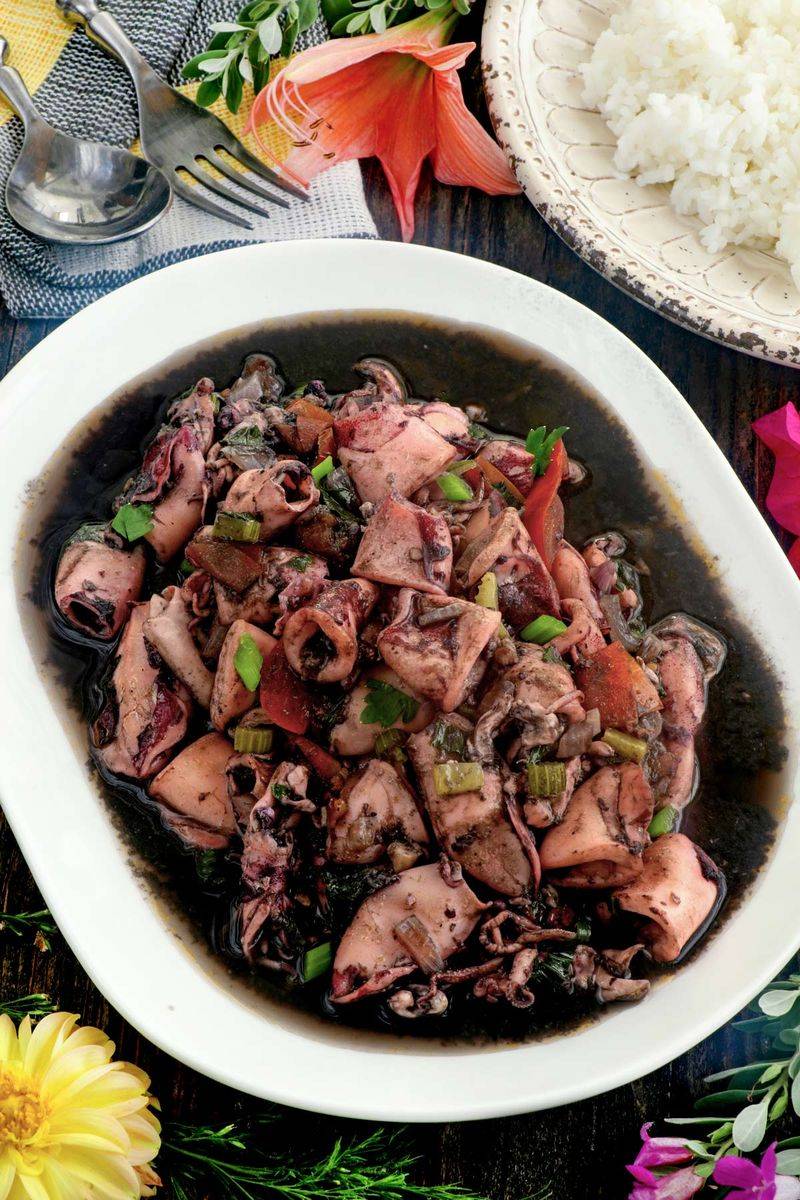
Adobong Pusit, or squid cooked in its own ink with vinegar and garlic, offers a bold, briny flavor that locals adore. The inky sauce creates a savory depth, making this dish a distinct Filipino favorite. Its preparation emphasizes the natural taste of squid, complemented by the tanginess of vinegar and the richness of garlic. Adobong Pusit is a testament to the Filipino appreciation for seafood and inventive cooking methods. While its appearance may seem unusual to some, it captures the adventurous spirit of local cuisine and is a cherished dish among Filipinos.
12. Laing

Laing hails from the Bicol region and features taro leaves stewed in coconut milk, enhanced with chilies and shrimp paste. This dish stands out for its creamy texture and robust flavors, making it a beloved choice for those who enjoy a bit of spice. Laing exemplifies the Bicolanos’ skill in balancing heat and creaminess, resulting in a dish that is both comforting and exciting. Often served with rice, its rich, flavorful sauce makes it a favorite among locals. Laing showcases the diversity of Filipino regional cuisine, appealing to both adventurous and traditional palates.
13. Lumpiang Shanghai

Lumpiang Shanghai, crispy spring rolls filled with seasoned ground pork, are a staple at Filipino celebrations. These bite-sized delights offer a satisfying crunch and savory filling, making them a crowd favorite. Served with a sweet and tangy dipping sauce, Lumpiang Shanghai is enjoyed by both young and old alike. Its straightforward preparation and universal appeal have earned it a permanent spot at gatherings, symbolizing Filipino hospitality and warmth. This dish’s popularity extends beyond mere taste, representing the joy and togetherness of sharing food with loved ones at festive occasions.
14. Chicken Inasal

Chicken Inasal is a specialty from Bacolod, characterized by its flavorful marinade and grilling method. Marinated in a blend of vinegar, calamansi, and annatto, the chicken is grilled to perfection, achieving a smoky aroma and juicy texture. Often served with garlic rice and a side of dipping sauce, Chicken Inasal is a testament to the vibrant flavors of Filipino barbecue. This dish is a favored choice at outdoor gatherings and family picnics, offering a taste of Filipino culinary artistry and tradition. Its enticing aroma and rich flavors make it a must-try for barbecue enthusiasts.
15. Bicol Express
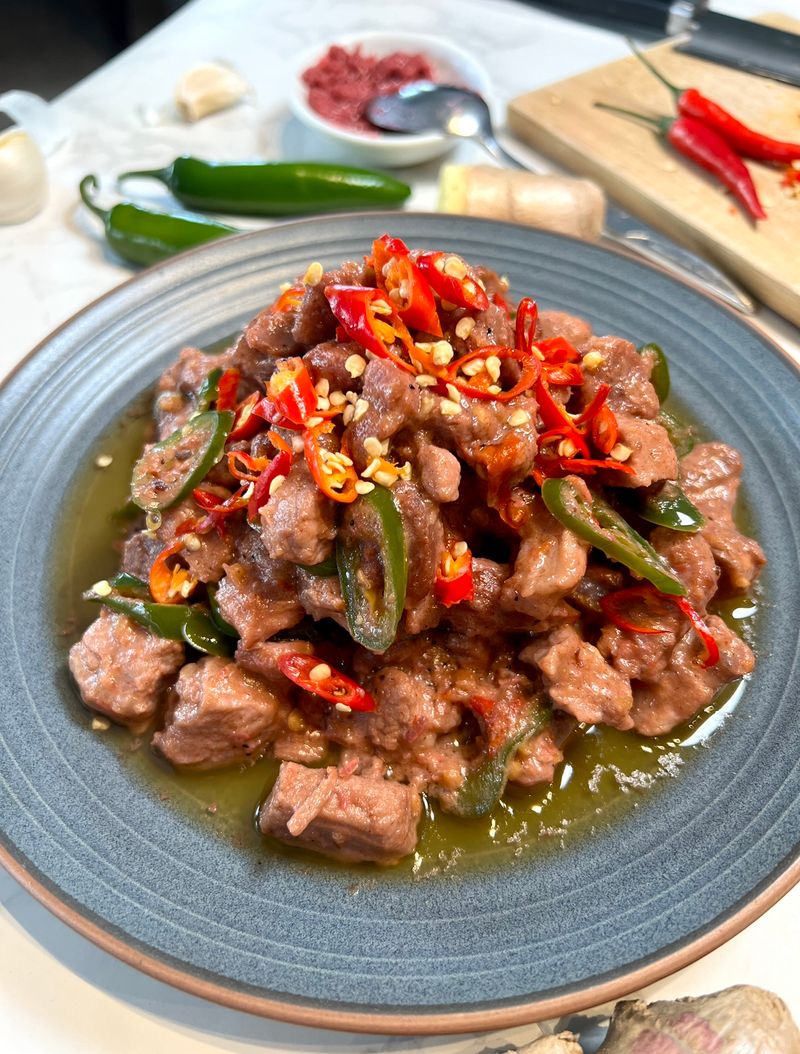
Bicol Express, a spicy stew of pork in coconut milk, is a culinary gem from the Bicol region. Known for its fiery kick, this dish combines the creaminess of coconut milk with the heat of chilies, creating a rich, savory experience. Bicol Express embodies the adventurous spirit of Filipino cuisine, appealing to those who crave bold flavors. Often paired with rice, it highlights the Bicolanos’ love for spice and innovation in cooking. This dish captures the heart of Filipino food culture, offering a taste of regional diversity and culinary creativity to all who indulge.
16. Ginataang Kalabasa at Sitaw
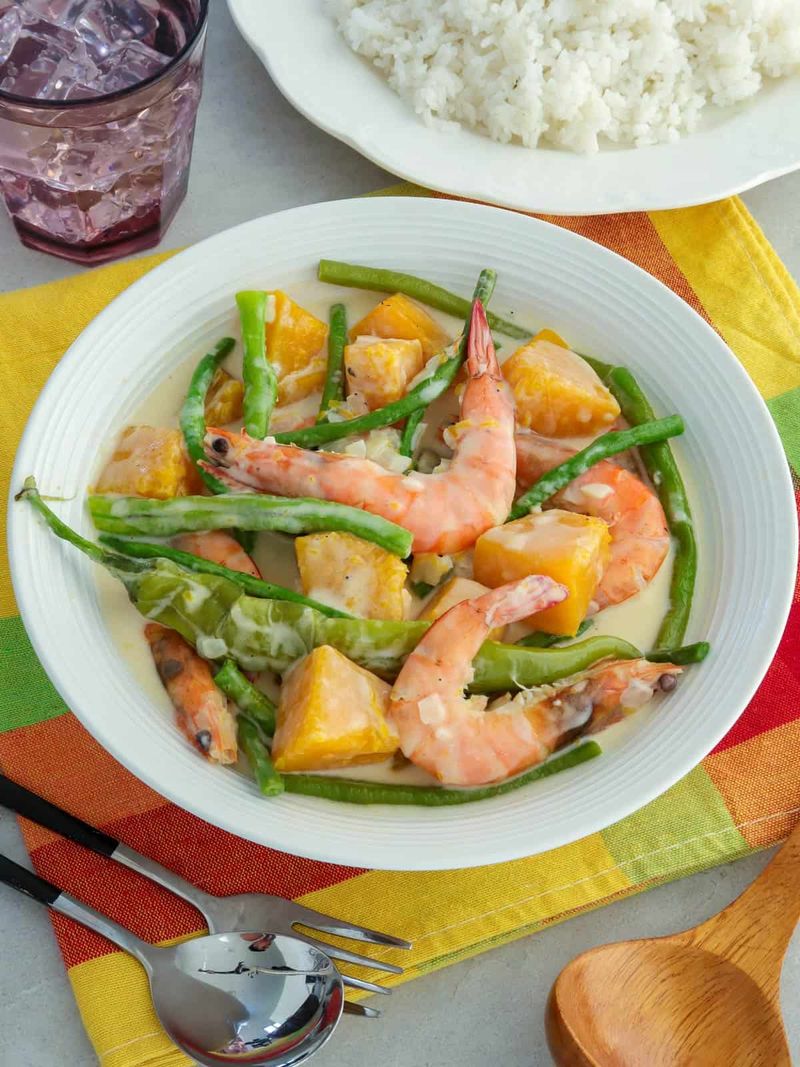
Ginataang Kalabasa at Sitaw, a comforting vegetable stew, combines squash and string beans in a savory coconut milk broth. This dish reflects the Filipino affinity for coconut-based stews, offering a rich yet wholesome meal. Often enhanced with shrimp or dried fish, it provides an umami boost that complements the creamy sauce. Ginataang Kalabasa at Sitaw is cherished for its simplicity and heartiness, making it a beloved choice for family meals. Its harmonious blend of flavors showcases the versatility of Filipino ingredients and the comforting nature of home-cooked dishes.
17. Tokwa’t Baboy
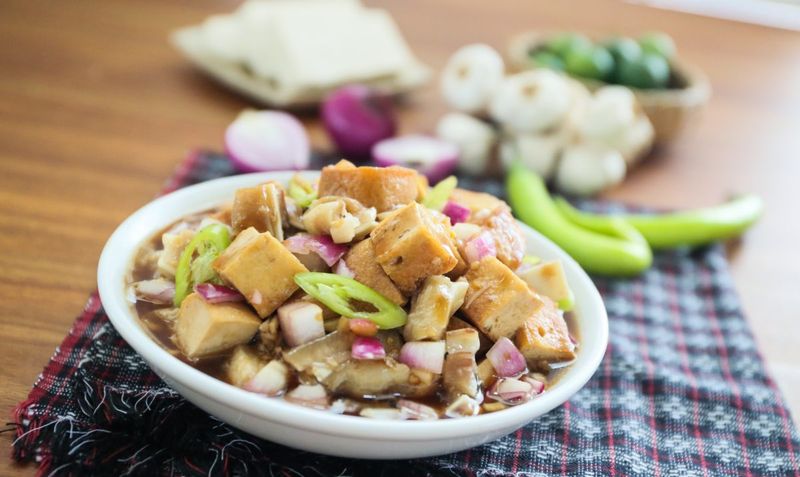
Tokwa’t Baboy combines fried tofu and boiled pork in a tangy soy-vinegar sauce, making it a popular bar snack and side dish. Its combination of textures, from the crispy tofu to the tender pork, offers a delightful contrast. The dipping sauce adds a burst of umami and sour notes, elevating the dish’s flavor profile. Tokwa’t Baboy is a staple at gatherings, enjoyed alongside drinks and shared among friends. It epitomizes the casual, communal atmosphere of Filipino dining, inviting both locals and visitors to relish the simple yet satisfying joys of Filipino cuisine.
